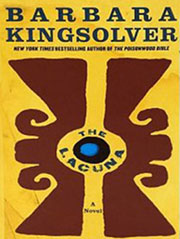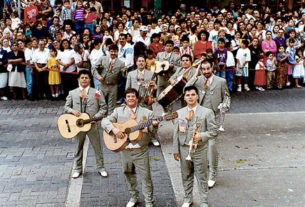Good Reading
The Lacuna: A Novel
A Mexico book by Barbara Kingsolver
 HarperCollins Publisher, 2009
HarperCollins Publisher, 2009
Available from Amazon Books: in Hardcover, Softcover, and Kindle
“Mexico admits you through an arched stone orifice into the tree-filled courtyard of its heart, where a dog pisses against a wall and a waiter hustles through a curtain of jasmine to bring a bowl of tortilla soup, steaming with cilantro and lime.”
Barbara Kingsolver, one of our novelistas mas estimadas, citizen both of a farm in southern Appalachia and of the world, seduces us once again into a tale well told, a tale of passion and intrigue, of politics and despair, of conspiracy and love. Much of her latest novel, The Lacuna, is set in Mexico, during the still turbulent decades that followed the Mexican Revolution.
Kingsolver’s lonely protagonist, Harrison Shepherd — born to a capricious Mexican mother and to a largely absent American father — is, at age twelve, taken by his mother, Salomé, to live a rather isolated life on Isla Pixo, a little island off of the southern coast of Mexico. There, Salomé is determined to win the permanent affection of Enrique, her already married lover. The boy, Harrison, finds companionship both working in the kitchen and reading the adventure novels of writers like Victor Hugo, Jules Verne, and Alexander Dumas. “The Three Musketeers… called out to him, waving their swords….”
Harrison finds solace in the sea (“in deep water you can soar”) and in the cave that “lay under the water,” sometimes “too far below the surface to find.” Leandro, his co-worker in the kitchen (Harrison loves to cook), tells him to stay in the shallows, because “the tides are complicated.” It is a lacuna, Leandro tells him: “Not a cave exactly, but an opening, like a mouth, that swallows things.”
But, like all heroes, the boy must leave his little island and move into more complicated experiences. His mother takes him to Mexico City where her lover has provided her with a casa chica above a bakery shop.” Her lover takes them both to Sanborn’s (introducing his mother as his “niece visiting for the year).” In Sanborn’s, “Waitresses in long, striped skirts brought carts of rainbow-colored juices: pomegranate, pineapple, guayaba” and American oil men offer opinions of Mexico:
“One told his theory about why America is forward and Mexico is backward: when the English arrived in the New World, they saw no good use for Indians, and killed them. But the Spaniards discovered a native populace long accustomed to serving masters (Azteca), so the empire yoked these willing servants to its plows to create New Spain. He said that was their mistake, allowing native blood to mingle with their own to make a contaminated race. The doctor agreed, saying the mixed-race mestizos have made a mess of the government because they are smoldering cauldrons of conflicting heritages.’ The mestizo is torn by his opposing racial impulses. His intellect dreams of high-minded social reforms, but his brute desires make him tear apart every advance his country manages to build.'” (The young Harrison thinks, “Yes, only, which half of the mestizo brain is the selfish brute: the Indian or the Spanish.”)
In Mexico City, Harrison soon Diego Rivera, who needs a young man to mix plaster for his current mural, and later he meets Rivera’s wife, Frida Kahlo, at the market in Coyoacán. Harrison becomes deeply fond of Frida: “Señora Frida is a confusion of terms: sometimes like a stern little man, then suddenly a woman or a child, but in every form demanding that you remain in love with her.”
After a short interlude in Washington, D.C., at the Potomac Academy, which was “A prison camp in brick buildings built to look like mansions,” Harrison returns to Mexico, this time to live with Diego and Frida, serving both as cook and informal secretary to the household, which includes Lev Trotsky — Lenin’s natural heir, who is living a dangerous exile in Mexico as Stalin’s henchmen hunt him down.
Diego and Frida live in adjacent houses joined together by a system of stairs. Frida tells Harrison: “You’re not completely Mexican, and not all gringo either. You are like this house, Insólito [“the oddball”]. A double person made of two different boxes.” She continues, “In the house of your mother, a taste for beauty and poetry. Secret passions, I suspect. And in the gringo side, a head that’s always thinking and surviving.”
The Mexico of the 1930s that Kingsolver invites us into is not the Mexico of pre-Revolutionary days. Trotsky, after the first attack on his life, is moved to San Miguel Regla: “The road to Regla passes near the great pyramids of Teotihuacán. Then through little mountain towns, steep streets filled with taverns, donkeys and dust, and pink colonial mansions from an earlier time, before it was shameful in Mexico to be rich. Now the mansions are all apartments, displaying laundry from their balconies.”
Harrison’s ambitious mother, Salomé, after a succession of lovers but never a successful permanent one, and after her “life of such large hopes,” dies in “Her last apartment: one room above a lace-and-girdle shop.” Her son returns to his native land and settles in Asheville, North Carolina, at the boarding house of Mrs. Bittle. There the second half of the novel begins.
And there at the boarding house he meets the widow Violet Brown who becomes his “archivest,” his assistant, his platonic companion, his surrogate mother, his most trusted advisor.
Harrison becomes a popular author of novels set in Mexico centuries earlier. His first book, Vassals of Majesty, sells 50,000 copies in its first month. These are followed by other novels that appeal to the public imagination, and he becomes highly successful, even a celebrity.
Because he is a celebrity, and because he is now in the public eye, he comes under the scrutiny of J. Edgar Hoover and of the House Un-American Activities Committee, during the wave of anti-communist sentiment that caught a nation by surprise and that for several years flooded over the country, drowning out reason and humanity. Mrs. Brown insists that the introverted and politically naïve author protect himself: “Mr. Shepherd, ye cannot stop a bad thought from coming into your head. But ye need not pull up a chair and bide it sit down.”
Because one morning years earlier in a Mexican market he carried groceries for a fascinating Mexican woman and consequently later became part of the household of Frida Kahlo and Diego Rivera — two well known communists — a household that also included Lev Trotsky, Harrison officially becomes a suspected traitor to the United States.
Shepherd has only one real desire in life: ‘To make something beautiful, that people would find very moving.” (To which one of Trotsky’s guards responds, “Pendejo, you do that every day in the kitchen.)
The Lacuna is told through Shepherd’s diaries, which were rescued both by Frida Kahlo and later by Mrs. Brown. The faithful Mrs. Brown, keeping her promise, waits decades before organizing the diaries and clippings — which include actual articles reprinted from places like the New York Times, and Life in the 1930s and 1940s into the book that becomes The Lacuna.
And the shy, thoughtful Harrison becomes, after all, a bit of a hero, even sensitive to the limitations of his persecutors: “probably they were all aimed at heaven at one time, and lost their way.”


